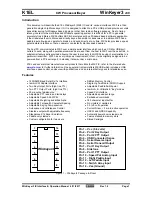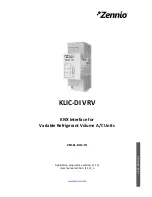
CNT-SVX07D-EN
39
Sequence of operations
Two-position control of a modulating outdoor air damper
The Tracer ZN521 does not support a two-position outdoor air damper actuator. However, a
modulating outdoor/return air damper actuator can be used for two-position control. Two-position
control can be accomplished by not providing an outdoor air temperature (neither hard-wired nor
communicated) to the controller, and by setting the damper minimum position (using the Rover
service tool) to the desired value (typically, 100%).
Face-and-bypass damper operation
The Tracer ZN521 can control a face-and-bypass damper to modulate a percentage of air to the face
of the coil(s) and around (bypass) the coil(s) to maintain zone comfort.
For two-pipe changeover
applications, if the controller requests heating and hot water is available, the face-and-bypass
damper modulates to the face position. If the controller requests heating and hot water is not
available, the face-and-bypass damper remains in the bypass position, and water sampling may
be initiated (see
“Entering water temperature sampling function,” p. 35
). For four-pipe changeover
applications, both heat and cool capacity are assumed to be available.
Face-and-bypass, isolation-valve operation
A Tracer ZN521 with a face-and-bypass damper controls on/off isolation valve(s) to prevent
unwanted water flow through the coil(s) when no airflow is passing over the coil (100% bypass).
In two-pipe applications, the isolation valve stops water flow, preventing radiant heat (heating
mode) and excessive condensate (cooling mode) from the coil. In four-pipe applications, the
isolation valves are used to prevent simultaneous heating and cooling.
The heating or cooling isolation valve opens whenever capacity is requested (>0%) as the face-and-
bypass damper begins to modulate toward the coil face. The isolation valve closes when capacity
returns to 0%.
DX cooling operation
The Tracer ZN521 supports one stage of direct expansion (DX) compressor operation for cooling
only.
Note:
The controller does not use the DX compressor and economizing simultaneously. Not doing
so prevents short cycling from occurring if the entering air temperature is too low for the
evaporator coil to operate as designed.
Electric heat operation
The Tracer ZN521 supports both single-stage and two-stage electric heat. Electric heat is cycled on
and off to maintain the discharge air temperature at the active heating setpoint. Two-pipe
changeover units with electric heat use the electric heat only when hot water is not available. The
use of both electric and hydronic heat is not supported.
Baseboard heat operation
When configured for baseboard heat output, the controller turns on baseboard heat at 2.2°F (1.2°C)
below the active heating setpoint, and turns off baseboard heat at 0.8°F (0.4°C) below the active
heating setpoint. The range for activating the baseboard heat cannot be adjusted; however, the
heating setpoint is configurable using the Rover service tool.
Baseboard heating is used most effectively when the discharge air temperature control high limit
is set below 100°F (56°C). If this is done, the unit heat will maintain the temperature on light load
days and the baseboard heat will be enabled to maintain the temperature on heavier load days.
Содержание Tracer ZN521
Страница 59: ......
















































